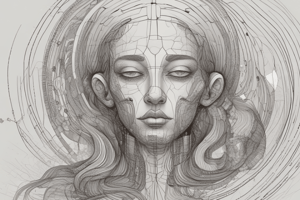Podcast
Questions and Answers
What is one primary function of art in society?
What is one primary function of art in society?
- To conform to societal norms
- To solely entertain audiences
- To reflect and shape cultural values and identities (correct)
- To create financial independence for artists
Which of the following art movements is characterized by a focus on emotional resonance and personal expression?
Which of the following art movements is characterized by a focus on emotional resonance and personal expression?
- Dadaism
- Renaissance
- Baroque
- Surrealism (correct)
Which of the following is NOT a criterion commonly used to assess artistic value?
Which of the following is NOT a criterion commonly used to assess artistic value?
- Cultural context
- Technical skill
- Emotional resonance
- Popularity among critics (correct)
In what way can an artist's work be affected by their environment?
In what way can an artist's work be affected by their environment?
Which art form uses genres to categorize works based on subjective themes and styles?
Which art form uses genres to categorize works based on subjective themes and styles?
How has the perception of 'art' evolved throughout history?
How has the perception of 'art' evolved throughout history?
Which of the following best describes a common impact of art on public discourse?
Which of the following best describes a common impact of art on public discourse?
Why is there no universally accepted standard of artistic merit?
Why is there no universally accepted standard of artistic merit?
Flashcards
Art's Functions
Art's Functions
Art serves various purposes in society, including reflecting and shaping cultural values, beliefs, and identities, and influencing social and political change.
Art Appreciation
Art Appreciation
Evaluating art based on sensory and emotional impact, technical skill, originality, emotional resonance, and cultural context.
Art Forms
Art Forms
Different ways art is expressed, such as painting, sculpture, music, literature, film, and dance.
Art Genres
Art Genres
Signup and view all the flashcards
Evolution of Art
Evolution of Art
Signup and view all the flashcards
Cultural Influence on Art
Cultural Influence on Art
Signup and view all the flashcards
Art Historical Periods
Art Historical Periods
Signup and view all the flashcards
Aesthetic Judgment
Aesthetic Judgment
Signup and view all the flashcards
Study Notes
History and Development
- Art encompasses a vast range of human creative activities and expressions.
- Art forms vary significantly across cultures and historical periods.
- Early art often served practical purposes, such as depicting hunting scenes or rituals.
- Over time, art evolved into a means of expressing personal emotions and interpretations, societal values, and spiritual beliefs.
- Different art movements have emerged throughout history, each with unique characteristics and aspirations.
- Examples include the Renaissance, Baroque, Impressionism, and Surrealism
Aesthetics and Criteria
- Aesthetic appreciation involves evaluating the sensory and emotional impact of art.
- Art often evokes emotions like joy, sorrow, awe, or reflection.
- Different criteria are used to assess artistic value, including technical skill, originality, emotional resonance, cultural context, and historical significance.
- There is no single, universally accepted standard of artistic merit.
- Individual preferences and cultural backgrounds significantly influence aesthetic judgment.
- The appreciation of art can be greatly influenced by the surrounding environment and social conditions at the time of creation of the art piece.
Forms and Genres
- Art exists in various forms, including painting, sculpture, drawing, printmaking, photography, architecture, music, literature, film, dance, and performance art.
- Genres within individual art forms further categorize works according to their subject matter, style, and intent.
- Examples in painting include portraiture, landscape, still life, and abstract art.
- Artistic expression can reflect specific themes, genres, styles, or periods.
Functions and Impact
- Art plays a crucial role in society by reflecting and shaping cultural values, beliefs, and identities.
- Art can serve a variety of functions, including personal expression, social commentary, historical record, and religious or spiritual practice.
- Art can promote social and political change by challenging norms and inspiring dialogue.
- Art influences public discourse and shapes perceptions of the world and human experience.
- Art also has economic value, with art pieces frequently being traded and collected by individuals.
- Art can have profound effects on individual psychology, and on societies as a whole.
- Art can evoke awe, reflect social commentary, and serve as a record of time.
Contemporary Issues
- Contemporary art frequently engages with complex social and political issues.
- Emerging technologies influence and redefine artistic practices.
- Artistic production and distribution methods are constantly evolving.
- Digital art and other digital creative endeavors are becoming increasingly prominent.
- Intersectionality plays an increasing role in art and its critical evaluation.
- Ethical considerations around artistic expression and the art market are growing.
Studying That Suits You
Use AI to generate personalized quizzes and flashcards to suit your learning preferences.




